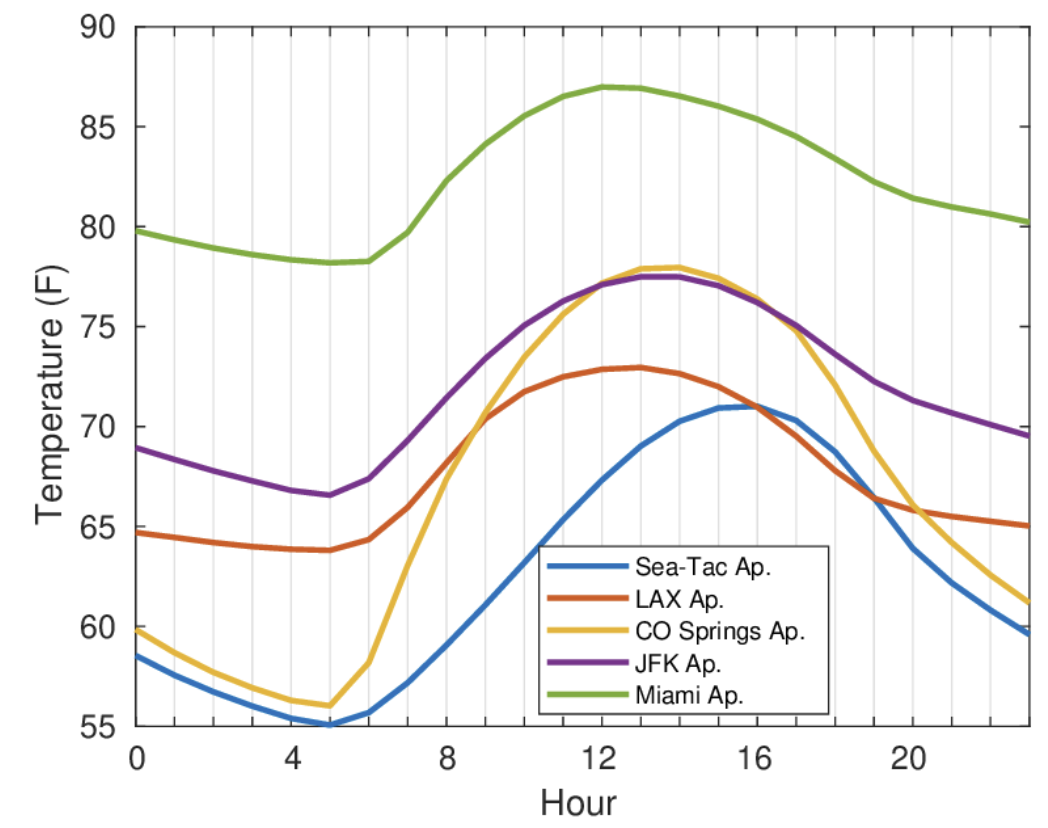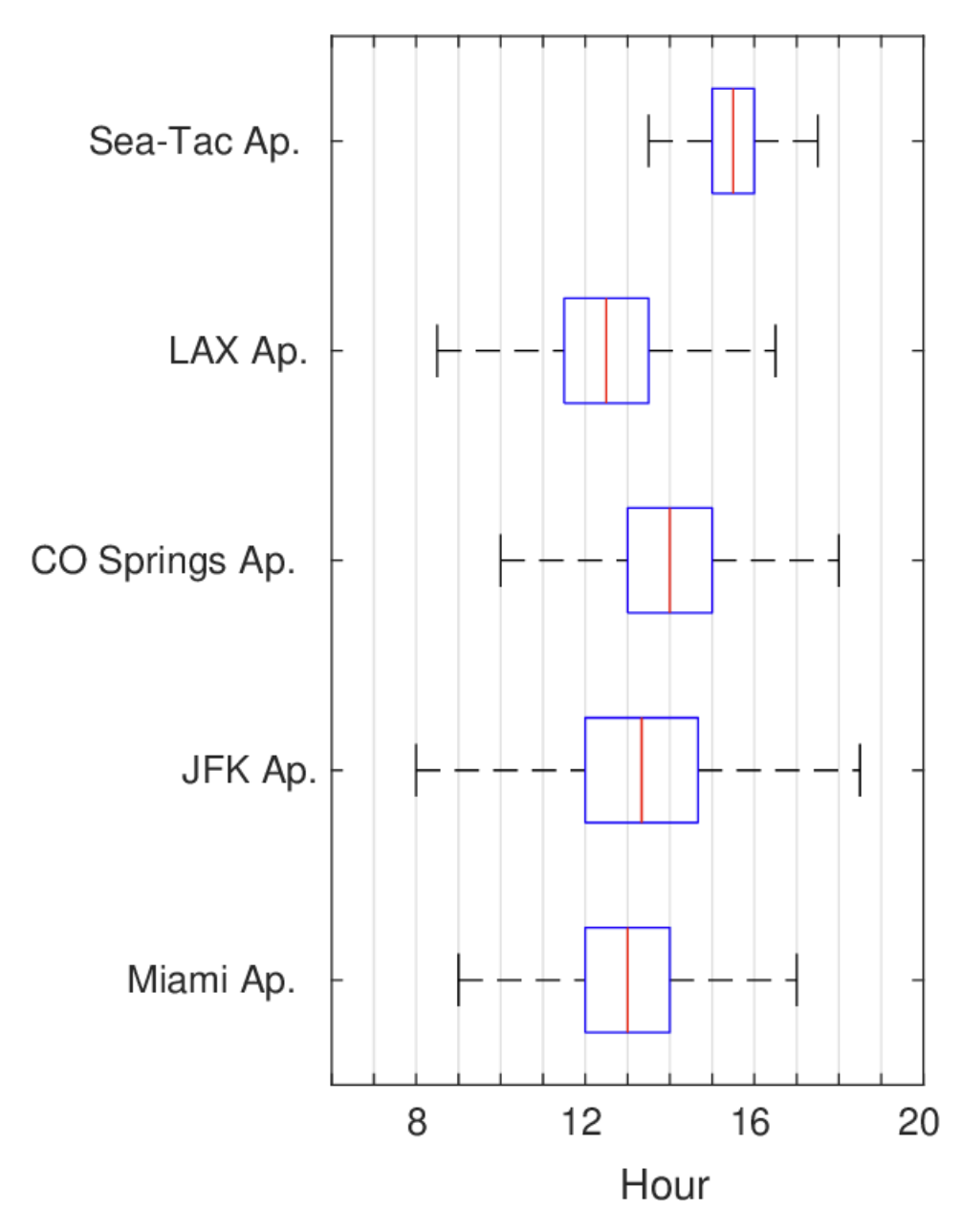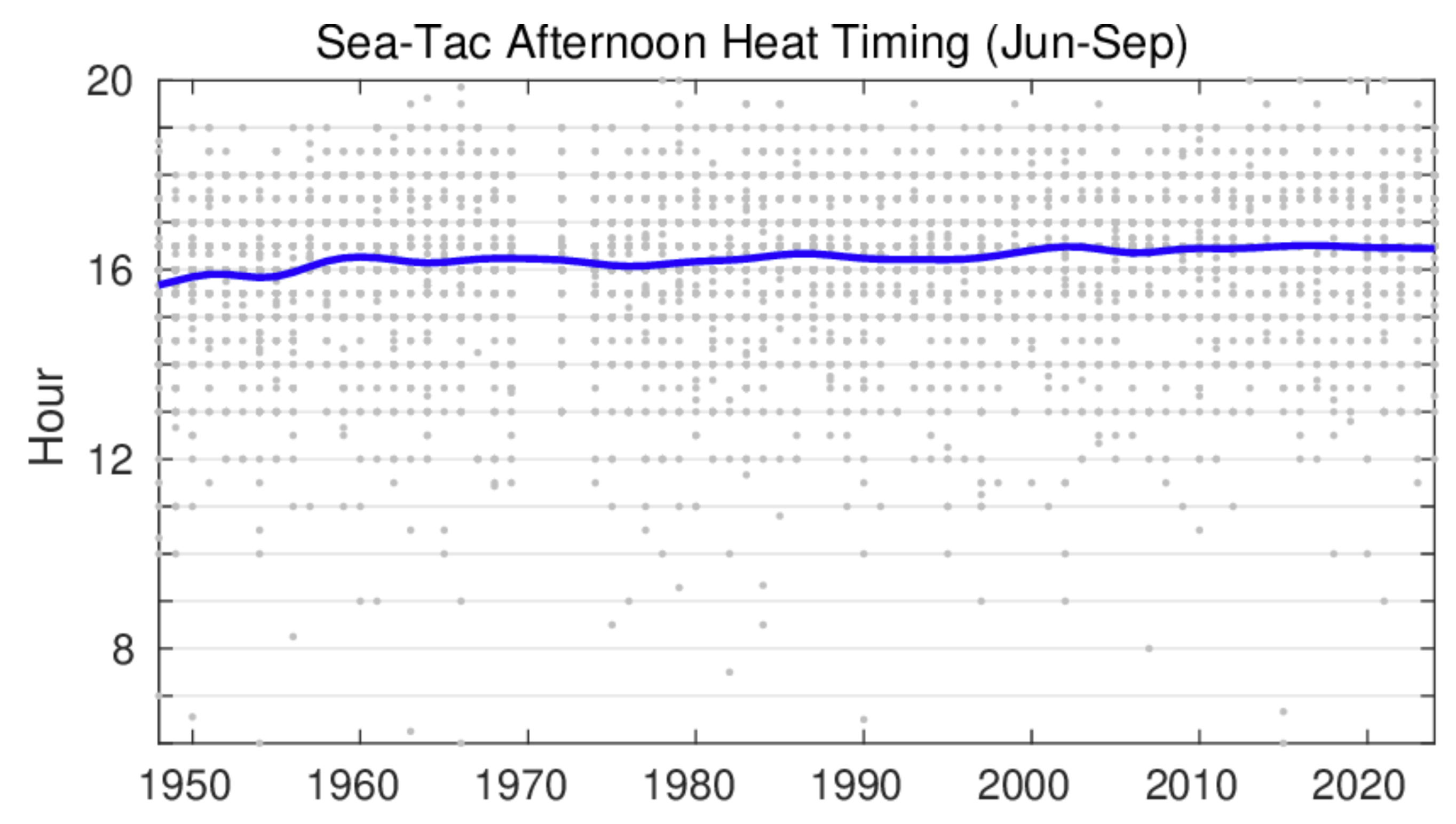Our Afternoon Heat Comes Later
Editor’s note (08/13/2025 4:30pm): Time of day was previously shown in standard time on the graphs below, in error. The graphs and text are now updated to Pacific Daylight Time.
One of the things I really appreciate about living here is how late it stays light out. I moved to Seattle from San Diego in 2008 (I know, another Californian), and that shift in latitude made a huge difference in the length of the day. Of course, the days are also much shorter in winter here, but I enjoy the variety.
Even though they might go hand-in-hand, I hadn’t thought until recently about how our afternoons seem to stay hotter later than what I’ve seen elsewhere. I decided to take a look at it for this month’s newsletter. The plot below shows the average temperature for each hour of the day for June-September, at airports across the country (if you’re wondering about June gloom, I also tried July-Sept and got basically the same answer). I’m looking at airports because those often have the longest observational records, especially for hourly data.

Of course, the first thing that jumps out is that these other cities are much warmer than us, both at night and during the day. And I’m only showing temperature here – if we add in humidity and look at the heat index, the differences are even more striking, especially for Miami.
The other interesting thing is the timing of the warmest temperature of the day. Since the averages can sometimes mask important variations, I’ve included a box plot showing the range of timing for the daily maximum temperature. You can see that there’s a lot of variation, but most events stick to a consistent pattern. For all of the other cities, the hottest temperatures tend to happen between 12 and 3pm local time (hours 12-15 on the graph). But for Seattle, the hottest hours of the day are between 3 and 4pm (hours 15-16). The timing of this late-afternoon heat also tends to be a bit more consistent in Seattle, as shown by the narrower range in the boxplot for Sea-Tac compared to the other cities.

(A quick technical side note: This is in local daylight savings time. Some locations are further west or east within their time zones, which can skew the results. If we wanted to get really precise here, we would be looking at solar time, or sun angle. Since this detail can only shift things by plus or minus roughly 1 hour, we’re sticking to time zones for simplicity.)
Back to the bigger question: Why? Why does the heat linger through our afternoons when it doesn’t do the same elsewhere? Humidity isn’t the only explanation, because it’s pretty dry here – especially compared to the other locations. This is actually pretty surprising, because in general we expect temperatures to stay hot longer when there’s more humidity – water vapor is a greenhouse gas, so it suppresses cooling. Another possibility is that we’re surrounded by water, and water takes longer to heat up. This is probably part of the story, but Spokane’s afternoons are hot later too, just like Seattle’s. So the maritime effect can’t be the only explanation (side note: the weather at Sea-Tac can often be different than in Seattle, and there are likely variations in afternoon heat timing across Puget Sound; we didn’t look at those for the current analysis). Another factor is cloudiness. In spite of our gloomy reputation, our summers are gloriously sunny (especially compared to our winters). But in other places, especially east of the Rockies, summer is a time of thunderstorms. The timing and intensity varies from place to place, of course, but often the pattern is that clouds build into the afternoon. Clouds don’t always bring rain, but they always bring shade – causing temperatures to moderate. This is probably a major factor for the New York, Miami, and Colorado stations. West of the Rockies summer thunderstorms are not as common, mainly because our slice of the Pacific Ocean is much cooler than the Gulf of Mexico and eastern seaboard. So for LA the explanation is different: it’s the shorter days. Like I said at the start, we’re way farther north than southern California, and our longest day of the year is almost 2 hours longer than for LA. Finally, where we sit in our time zone can also make a difference – see the maps here for the bizarre effects of our meandering time zone delineations on sunset timing.
This leaves us with the somewhat complicated takeaway that there are several factors at play: afternoon clouds are likely important east of the Rockies, length of day is a factor, maritime influence both suppresses thunderstorms and delays afternoon warming, and where we sit in our time zone could skew things slightly.
One of the reasons we want to understand the cause for this kind of thing is curiosity. Another is to know if we should expect changes under certain conditions, or over time. Since the main factors for Seattle are our proximity to Puget Sound and our latitude, we don’t expect these to change much over time. Below I’m showing a plot of the peak heat timing at Sea-Tac since 1948 (the average line is smoothed with an 11-year moving average just to make it more readable).

There appears to be a slight shift to later times over the course of the record, but the change is small and likely not statistically significant. So based on our sleuthing about the cause, and with the observational data to back it up, we don’t expect this to change much over time – our late afternoon heat is here to stay. Either way, keep in mind that on really hot days you’ll need to find ways to stay cool through the late afternoon. And when it’s not too hot, enjoy it while we’re still in summer!